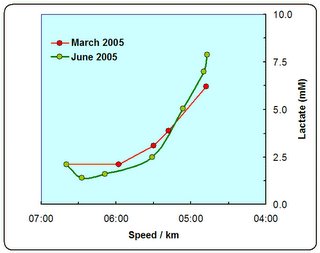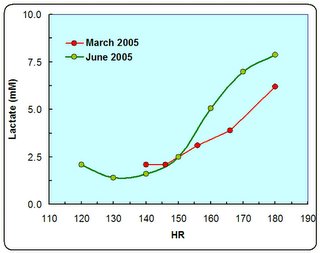There are many theories on how to train for sport, far more than we can ever hope to cover in this forum. However, many of these theories have common elements that indicate universal importance in training. When we look at training zones and how hard we need to work to get fitter, faster or stronger many programs identify the anaerobic threshold (AnT) as a key parameter. I think that it would be a great subject to talk about this a little.
While a few sentences ago I mentionned the concept of AnT was relatively universal in sport training theory, it is never that simple as there are many interpretations of [AnT , how to identify it, what it represents and how to use it in training.
First we should look at what the AnT is intended to represent. When we exercise we require energy, and the human body gets this energy from two main sources; aerobic and anaerobic sources. Using real world comparisons, aerobic energy is a very eco friendly, renewable energy source; while anaerobic energy is high-octane, heavily polluting limited supply energy source.
At all times you are using both aerobic and anaerobic energy sources in some proportion. At low intensity levels (i.e. reading this post, walking, paddling wiht your Great-Granny, etc.) you will be primarily aerobic, while short duration, high intensity efforts (i.e. pounding out a regatta start, 1/4 mile or linking waves at 20 +Kn, etc.) you will be primarily anaerobic.
At some point intensity-duration combination, you will produce more energy from anaerobic sources than aerobic sources. This is your AnT. Most sport science agrees to this point. How they define and measure this threshold varies greatly and thus how it applies to your training.
Anaerobic energy production is estimated using a convenient and relatively easy metaboilic by-product called lactic acid (also called simply lactate). Muscle lactate is mirrored to a certain degree in blood lactate, and this is the basis of many AnT estimation methods. Lactate concentrations in the blood are measured in a chemisty terminology value called the milimole (mM) per liter of blood, and values range from under 1.0 mM (i.e. easy exercise or rest) to over 20 mM (i.e. cross-eyed, tasting blood, ready to puke, forgot your name, want to die quickly). Heart rates and speeds can be assigned to lactate values as a measure of how much muscular work is being done.
This value can be between 70 and 95+% of your peak HR. Some very well trained aerobic athlete will often be able to race for 2+ hours at 95% of their peak HR. However, right next to him (or her) may be another athlete racing at only 80% of his (or her) peak HR.
The most simple forms of AnT use absolute lactate values. For example, there is a method favoured by the ex-eastern block sport scientists that uses a 4.0 mM marker. This is a great normative value when everyone uses the same training program and mass screening is necessary to determine who will fit the training plan. There is no questionning the sucess of many of these programs in swimming, track cycling, cross-country skiing and other sports. In this
method a HR and speed at 4.0 mM is identified and used in assigning training effort levels (i.e. 80% 4.0 mM pace, 110% 4.0 mM pace, etc.).
The next form of AnT is the individual anaerobic threshold (iAnT) which recognizes that each person is unique in their physiology. These estimation methods identify each individual's AnT by looking for the point where lactate value increase rapidly at the onset of significant anaerobic energy production. Each individual would then have a HR and speed associated with this value. As with the absolute AnT, training paces are assigned accordingly.
The many methods used to identify iAnT will each give you a slightly different value, which is important in assigning training zones, etc. Likewise at different time in the training season and in different sports (i.e. OC vs surfski vs swimmiing vs running). The simplest method requires a series of 3-4 minute efforts at set heart rates, followed by a very small finger tip blood sample (all tropical water paddlers shudder at the thought) and quick analysis in a small hand held device (takes about a minute).
Average speeds and HR are recorded, along wiht the lactate value. This continues in 10 beat per minute increments until the athlete can't hold the target HR for 3-4 minutes (i.e. 4 min at 100, 4 min at 110, 4 min at 120,... 3-4 min at 180+). Somewhere along there the lactate values will suddenly jump up and rise rapidly 2-3 steps before failure to finish a step.
This iAnT will indicate a long distance pace you should be able to hold for 1-3 hours depending on your fitness level, training program, hydration level, etc.
Other methods will overestimate this value resulting in an iAnT you can't hold very long (10-15 minutes), while others will underestimate it and give you a value you can hold all day.
Luckily for those who live in areas where certain fish love the scent of blood, iAnT can be roughly estimated using non-invasive methods. Your average HR from a long race will suffice, as will using your breathing rate. When your breathing rate increase rapidly, you've probably passed you AnT .
A more complicated method involves 2-4 time trials ranging from 1-10 minutes in length and doing some funky math on the results. This is called a critical speed test.
Here are sample lactate curves from a runner taken at two different times. One uses HR the other speed.
See if you can identify the anaerobic threshold in the pre training (March) and post training (June) testing, and offer up some thoughts on what has happened.


Alan Carlsson
Engineered Athlete Services
No comments:
Post a Comment